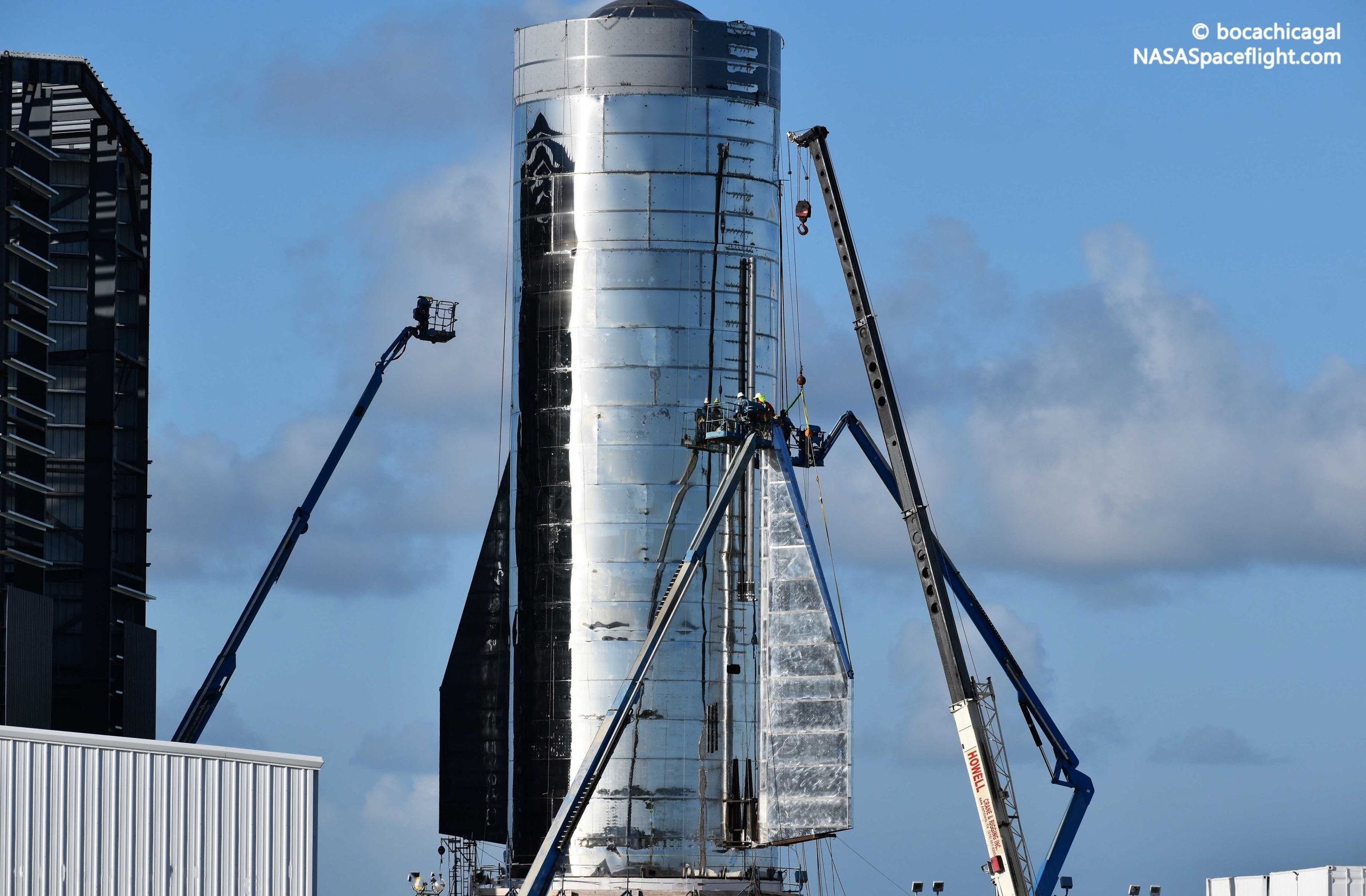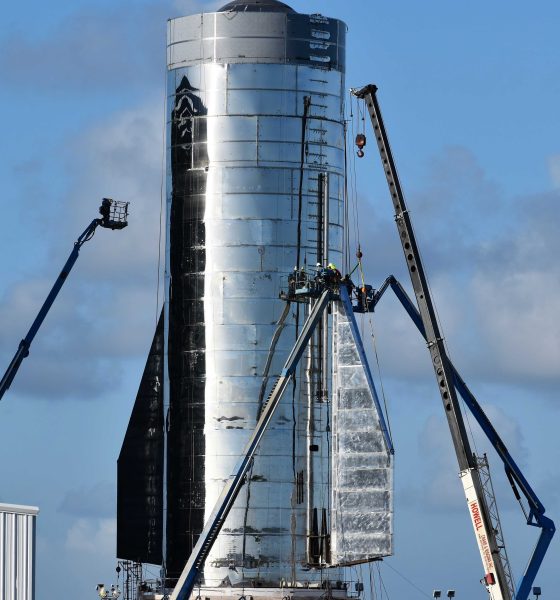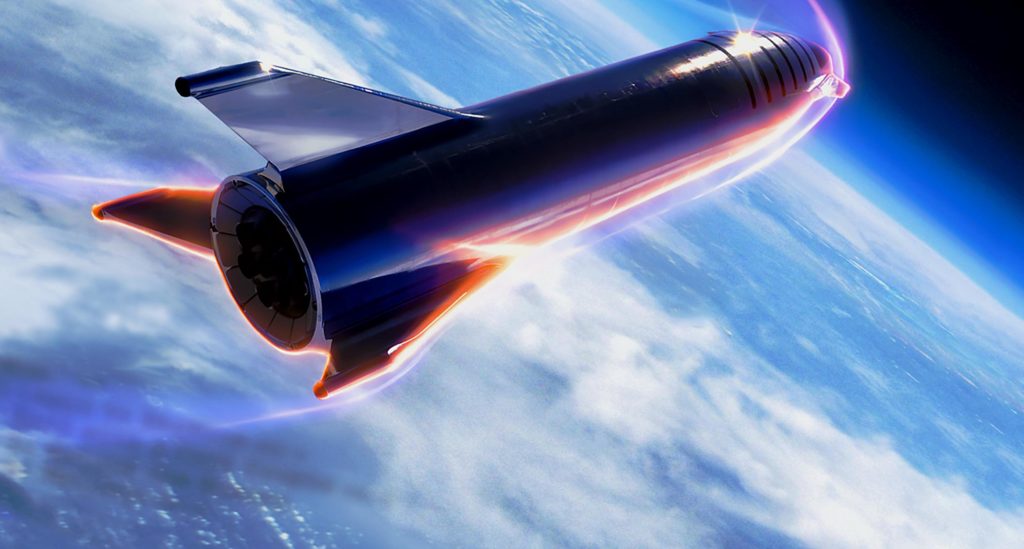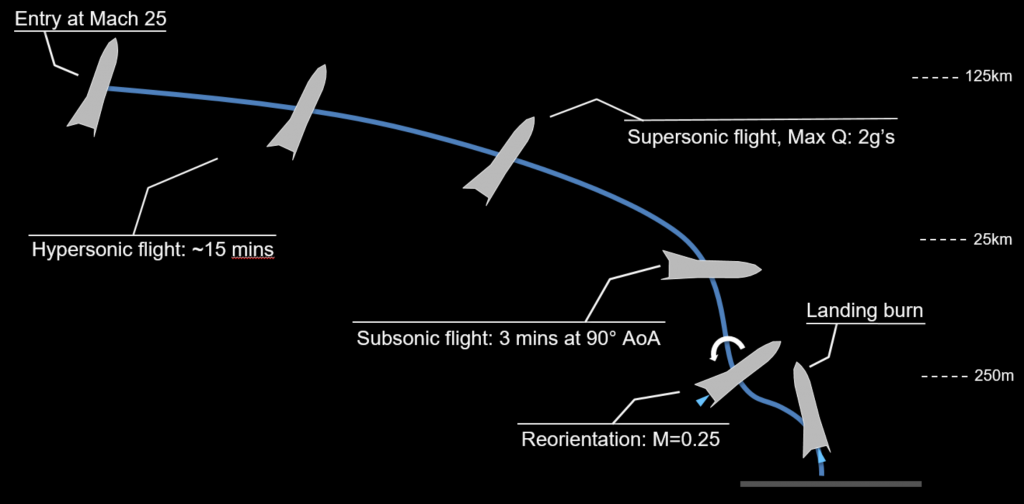

News
SpaceX CEO Elon Musk explains how Starships will return from orbit
In the near future, SpaceX wants to begin putting its first two full-scale Starship prototypes through a series of increasingly challenging test flights, eventually culminating in their first Super Heavy-supported orbital launch attempts.
SpaceX CEO Elon Musk took to Twitter over the last 48 or so hours to answer a number of questions about how exactly Starship is meant to make it through orbital reentries – by far the most strenuous period for the ship and without a doubt the single most challenging engineering problem SpaceX must tackle.

Discussed yesterday on Teslarati, SpaceX technicians began the process of attaching numerous Tesla Model S/X battery packs to a subcomponent that will eventually be installed inside Starship Mk1’s nose, offering a storage capacity of up to 400 kWh. The need for all that power (Crew Dragon relies on a few-kWh battery) is directly related to Starship Mk1’s methods of reentry and recovery, recently described in detail by Elon Musk.
As noted above, ~400 kWh of batteries are needed to power the electric motors that will actuate Starship’s massive control surfaces – two large aft wings and two forward canards/fins. According to Musk, Starship’s “stability is controlled by (very) rapid movement of rear & fwd fins during entry & landing”, meaning that the spacecraft will need to constantly tweak its control surfaces to remain in stable flight.

By far the biggest challenge SpaceX faces is ensuring that Starship can survive numerous orbital-velocity reentries with little to no wear and tear, a necessity for Starship to be cost-effective. In Low Earth Orbit (LEO), Starship will be traveling no less than 7.8 km/s (Mach 23, 17,500 mph) at the start of atmospheric reentry. In simple terms, the process of slowing from orbital velocity to landing on Earth involves turning the vast majority of that kinetic energy into heat. As Musk noted yesterday, this reality is just shy of unavoidable but there is some flexibility in terms of how quickly one wants to convert that energy into heat.
The fastest route to Earth would involve diving straight into the atmosphere, dramatically increasing peak heating on a spacecraft’s surface to the point that extremely exotic heat shields and thermal protections systems become an absolute necessity. SpaceX wants to find a middle ground with Starship in which the spacecraft uses its aerodynamic control surfaces and body to generate lift, slowly and carefully lowering itself into Earth’s atmosphere over a period of 15+ minutes. Musk notes that this dramatically lessens peak heating at the cost of increasing the overall amount of energy Starship has to dissipate, a bit like cooking something in the oven at 300 degrees for 30 minutes instead of 600 degrees for 10 minutes.
To an extent, Starship’s reentry profile is actually quite similar to NASA’s now-retired Space Shuttle, which took approximately 30 minutes to go from its reentry burn to touchdown. Per the above infographic, it looks like Starship will take approximately 20 minutes from orbit to touchdown, owing to a dramatically different approach once it reaches slower speeds. Originally described by Musk in September 2018 and again in recent weeks, Starship will essentially stall itself until its forward velocity is nearly zero, after which the giant spacecraft will fall belly-down towards the Earth, using its wings and fins to maneuver like a skydiver. The Space Shuttle landed on a runway like a (cement-encased) glider.
This unusual approach allows SpaceX to sidestep the need for huge wings, preventing Starship from wasting far more mass on aerodynamic surfaces it will rarely need. The Space Shuttle is famous for its massive, tile-covered delta wing and the leading-edge shielding that partially contributed to the Columbia disaster. However, it’s a little-known fact that the wing’s size and shape were almost entirely attributable to US Air Force demands for cross-range performance, meaning that the military wanted Shuttles to be able to travel 1000+ miles during reentry and flight. This dramatically constrained the Shuttle’s design and was never once used for its intended purpose.

SpaceX thankfully doesn’t have its own “US Air Force” stand-in making highly consequential demands (aside from Elon Musk ?). Instead, Starship will continue the SpaceX tradition of vertical landing, falling straight down – a bit like a skydiver (or a brick) – on its belly and flipping itself over with fins and thrusters for a propulsive vertical landing. In this way, Starship doesn’t have to be a brick forced to fly, like the Shuttle was – it just needs to be able to stably fall and quickly flip itself from a horizontal to vertical orientation.
Additionally, Starship is built almost entirely out of steel, whereas the Shuttle relied on an aluminum alloy and needed thermal protection over every square inch of its hull. Steel melts at nearly twice the temperature of the Shuttle’s alloy, meaning that Starship will (hopefully) be able to get away with nothing more than ceramic tiles on its windward half, saving mass, money, and time. Once Starship completes its first 20 km (12.5 mi) flight test(s), currently scheduled no earlier than mid-October, SpaceX will likely turn its focus on verifying Starship’s performance at hypersonic speeds, ultimately culminating in its first orbital-velocity reentries.
Check out Teslarati’s Marketplace! We offer Tesla accessories, including for the Tesla Cybertruck and Tesla Model 3.

Elon Musk
Elon Musk’s X will start using a Tesla-like software update strategy
The initiative seems designed to accelerate updates to the social media platform, while maintaining maximum transparency.

Elon Musk’s social media platform X will adopt a Tesla-esque approach to software updates for its algorithm.
The initiative seems designed to accelerate updates to the social media platform, while maintaining maximum transparency.
X’s updates to its updates
As per Musk in a post on X, the social media company will be making a new algorithm to determine what organic and advertising posts are recommended to users. These updates would then be repeated every four weeks.
“We will make the new 𝕏 algorithm, including all code used to determine what organic and advertising posts are recommended to users, open source in 7 days. This will be repeated every 4 weeks, with comprehensive developer notes, to help you understand what changed,” Musk wrote in his post.
The initiative somewhat mirrors Tesla’s over-the-air update model, where vehicle software is regularly refined and pushed to users with detailed release notes. This should allow users to better understand the details of X’s every update and foster a healthy feedback loop for the social media platform.
xAI and X
X, formerly Twitter, has been acquired by Elon Musk’s artificial intelligence startup, xAI last year. Since then, xAI has seen a rapid rise in valuation. Following the company’s the company’s upsized $20 billion Series E funding round, estimates now suggest that xAI is worth tens about $230 to $235 billion. That’s several times larger than Tesla when Elon Musk received his controversial 2018 CEO Performance Award.
As per xAI, the Series E funding round attracted a diverse group of investors, including Valor Equity Partners, Stepstone Group, Fidelity Management & Research Company, Qatar Investment Authority, MGX, and Baron Capital Group, among others. Strategic partners NVIDIA and Cisco Investments also continued support for building the world’s largest GPU clusters.
News
Tesla FSD Supervised wins MotorTrend’s Best Driver Assistance Award
The decision marks a notable reversal for the publication from prior years, with judges citing major real-world improvements that pushed Tesla’s latest FSD software ahead of every competing ADAS system.

Tesla’s Full Self-Driving (Supervised) system has been named the best driver-assistance technology on the market, earning top honors at the 2026 MotorTrend Best Tech Awards.
The decision marks a notable reversal for the publication from prior years, with judges citing major real-world improvements that pushed Tesla’s latest FSD software ahead of every competing ADAS system. And it wasn’t even close.
MotorTrend reverses course
MotorTrend awarded Tesla FSD (Supervised) its 2026 Best Tech Driver Assistance title after extensive testing of the latest v14 software. The publication acknowledged that it had previously criticized earlier versions of FSD for erratic behavior and near-miss incidents, ultimately favoring rivals such as GM’s Super Cruise in earlier evaluations.
According to MotorTrend, the newest iteration of FSD resolved many of those shortcomings. Testers said v14 showed far smoother behavior in complex urban scenarios, including unprotected left turns, traffic circles, emergency vehicles, and dense city streets. While the system still requires constant driver supervision, judges concluded that no other advanced driver-assistance system currently matches its breadth of capability.
Unlike rival systems that rely on combinations of cameras, radar, lidar, and mapped highways, Tesla’s FSD operates using a camera-only approach and is capable of driving on city streets, rural roads, and freeways. MotorTrend stated that pure utility, the ability to handle nearly all road types, ultimately separated FSD from competitors like Ford BlueCruise, GM Super Cruise, and BMW’s Highway Assistant.
High cost and high capability
MotorTrend also addressed FSD’s pricing, which remains significantly higher than rival systems. Tesla currently charges $8,000 for a one-time purchase or $99 per month for a subscription, compared with far lower upfront and subscription costs from other automakers. The publication noted that the premium is justified given FSD’s unmatched scope and continuous software evolution.
Safety remained a central focus of the evaluation. While testers reported collision-free operation over thousands of miles, they noted ongoing concerns around FSD’s configurable driving modes, including options that allow aggressive driving and speeds beyond posted limits. MotorTrend emphasized that, like all Level 2 systems, FSD still depends on a fully attentive human driver at all times.
Despite those caveats, the publication concluded that Tesla’s rapid software progress fundamentally reshaped the competitive landscape. For drivers seeking the most capable hands-on driver-assistance system available today, MotorTrend concluded Tesla FSD (Supervised) now stands alone at the top.
News
Elon Musk’s Grokipedia surges to 5.6M articles, almost 79% of English Wikipedia
The explosive growth marks a major milestone for the AI-powered online encyclopedia, which was launched by Elon Musk’s xAI just months ago.

Elon Musk’s Grokipedia has grown to an impressive 5,615,201 articles as of today, closing in on 79% of the English Wikipedia’s current total of 7,119,376 articles.
The explosive growth marks a major milestone for the AI-powered online encyclopedia, which was launched by Elon Musk’s xAI just months ago. Needless to say, it would only be a matter of time before Grokipedia exceeds English Wikipedia in sheer volume.
Grokipedia’s rapid growth
xAI’s vision for Grokipedia emphasizes neutrality, while Grok’s reasoning capabilities allow for fast drafting and fact-checking. When Elon Musk announced the initiative in late September 2025, he noted that Grokipedia would be an improvement to Wikipedia because it would be designed to avoid bias.
At the time, Musk noted that Grokipedia “is a necessary step towards the xAI goal of understanding the Universe.”
Grokipedia was launched in late October, and while xAI was careful to list it only as Version 0.1 at the time, the online encyclopedia immediately earned praise. Wikipedia co-founder Larry Sanger highlighted the project’s innovative approach, noting how it leverages AI to fill knowledge gaps and enable rapid updates. Netizens also observed how Grokipedia tends to present articles in a more objective manner compared to Wikipedia, which is edited by humans.
Elon Musk’s ambitious plans
With 5,615,201 total articles, Grokipedia has now grown to almost 79% of English Wikipedia’s article base. This is incredibly quick, though Grokipedia remains text-only for now. xAI, for its part, has now updated the online encyclopedia’s iteration to v0.2.
Elon Musk has shared bold ideas for Grokipedia, including sending a record of the entire knowledge base to space as part of xAI’s mission to preserve and expand human understanding. At some point, Musk stated that Grokipedia will be renamed to Encyclopedia Galactica, and it will be sent to the cosmos.
“When Grokipedia is good enough (long way to go), we will change the name to Encyclopedia Galactica. It will be an open source distillation of all knowledge, including audio, images and video. Join xAI to help build the sci-fi version of the Library of Alexandria!” Musk wrote, adding in a later post that “Copies will be etched in stone and sent to the Moon, Mars and beyond. This time, it will not be lost.”








